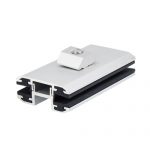
Standard: Hexagon Head Self Drilling Screw
Material: stainless steel A2-304,A4-316,SMO254,201,202,410
Size:from #6 to #14, from 3.5mm to 6.3mm
Length:from 3/4" to 5-1/2",from 16mm to 140mm
Surface finish:Plain or Customized
Packing: cartons with furmigated pallets
Supply ability: 50tons per month
Are you looking for a high-quality fastening solution for your construction or DIY project? If so, then you might want to consider using SS hex head self-drilling screws. These versatile fasteners offer several benefits over traditional screws, including increased efficiency, reduced labor costs, and enhanced corrosion resistance. In this guide, we'll take a closer look at SS hex head self-drilling screws, including their features, applications, installation process, and maintenance requirements.
What Are SS Hex Head Self-Drilling Screws?
SS hex head self-drilling screws are specially designed fasteners that combine drilling and tapping in a single operation. They are typically made of stainless steel, which provides excellent strength, durability, and resistance to rust and corrosion. The hexagonal head of these screws allows for easy tightening with a wrench or pliers, while the self-drilling feature eliminates the need for pre-drilling or tapping, thereby saving time and effort.
Features of SS Hex Head Self-Drilling Screws
SS hex head self-drilling screws come with several features that make them a popular choice among builders, contractors, and DIY enthusiasts. Some of the key features of these fasteners include:
Pointed Tip
SS hex head self-drilling screws have a pointed tip that allows them to penetrate the material without the need for pre-drilling. This feature reduces the installation time and effort required, as the screw can drill its own hole as it's being driven into the material.
Self-Tapping Threads
The threads of SS hex head self-drilling screws are designed to cut into the material, creating a secure and stable hold. This feature eliminates the need for tapping or pre-threading the material, making the installation process faster and more efficient.
Corrosion Resistance
Stainless steel is known for its excellent resistance to rust and corrosion, making SS hex head self-drilling screws ideal for outdoor and marine applications. The stainless steel construction of these fasteners provides long-lasting durability and reliability, even in harsh environments.
Hexagonal Head
The hexagonal head of SS hex head self-drilling screws allows for easy tightening with a wrench or pliers, providing a secure and stable hold. The head also offers a larger surface area for applying torque, reducing the risk of slippage or stripping.
Applications of SS Hex Head Self-Drilling Screws
SS hex head self-drilling screws are suitable for a wide range of applications, including:
Metal Roofing and Siding
SS hex head self-drilling screws are ideal for attaching metal roofing and siding panels to metal frames. Their self-drilling feature eliminates the need for pre-drilling, reducing the installation time and labor costs.
Decking and Fencing
SS hex head self-drilling screws are also suitable for attaching wooden decking and fencing to metal frames. Their self-tapping threads provide a secure and stable hold, while their corrosion-resistant properties make them ideal for outdoor applications.
HVAC Ductwork
SS hex head self-drilling screws can be used to attach HVAC ductwork to metal frames, providing a secure and stable hold. Their self-drilling feature eliminates the need for pre-drilling, making the installation process faster and more efficient.
Automotive and Marine Applications
SS hex head self-drilling screws are also suitable for automotive and marine applications, where corrosion resistance and durability are essential. Their stainless steel construction provides excellent resistance to rust and corrosion, ensuring long-lasting performance in harsh environments.
Installation Process of SS Hex Head Self-Drilling Screws
Installing SS hex head self-drilling screws is a straightforward process that requires only a few tools and materials. Here are the steps to follow:
Step 1: Choose the Right Screw
Select the appropriate size for the job and ensure that the thread type matches the material you are working with.
Step 2: Prepare the Material
Clean the surface and remove any debris or loose material. If necessary, use a metal primer to improve the adhesion of the screw.
Step 3: Position the Screw
Place the tip of the screw at the desired location and apply pressure while rotating the screw in a clockwise direction. The self-drilling tip will create a pilot hole and continue drilling until the screw reaches its desired depth.
Step 4: Tighten the Screw
Using a wrench or pliers, tighten the screw until it is snug against the material. Avoid over-tightening, as this can damage the material or strip the threads.
Step 5: Repeat as Necessary
Repeat the process for each screw, ensuring that they are evenly spaced and properly aligned.
Maintenance of SS Hex Head Self-Drilling Screws
To ensure the longevity and performance of SS hex head self-drilling screws, it's essential to follow some basic maintenance practices. Here are a few tips to keep in mind:
Regular Inspection
Inspect the screws periodically to ensure that they are tight and secure. Tighten any loose screws to prevent damage or failure.
Lubrication
Apply a small amount of lubricant to the threads and head of the screw to reduce friction and prevent galling. This will also make it easier to remove the screws if necessary.
Corrosion Prevention
If the screws are exposed to corrosive environments, consider applying a protective coating or using a more corrosion-resistant material. This will help to prevent rust and extend the lifespan of the screws.
Conclusion
SS hex head self-drilling screws are a versatile and efficient fastening solution for a wide range of applications. With their self-drilling feature, corrosion resistance, and easy installation process, they offer several benefits over traditional screws. By following the guidelines outlined in this guide, you can ensure that you are using these fasteners correctly and maximizing their performance and longevity.










